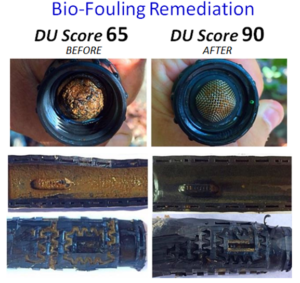Did you know that yields within a single grapevine row can vary up to 5x?
One factor in this yield variation is irrigation.
Poor Irrigation System Distribution Uniformity (DU) has been shown to negatively impact crop yields in numerous studies conducted over the past several decades. By managing DU and utilizing other tools for identifying uneven application of water across a field, these yield losses can be reversed. Performing DU analysis along with physical and visual inspections of the system components is the first step. Taking corrective action to restore the DU to at, or near design performance is the next step. Research shows that correcting pressure variations and/or remediating systems to eliminate plugging have the greatest impact on improving DU.
I have yet to meet a grower who does not agree with the statement, “Water and inputs directly affect yield.” No water equals no crop, and not enough water equals not enough yield. Truth is that yield improvement is the biggest reason why growers install micro irrigation in the first place. However, it is surprising how few users of micro irrigation are regularly measuring the effectiveness and uniformity of their irrigation systems. Most users are turning systems on for a set number of hours and assuming that the water and inputs are reaching the crop. Some use moisture monitoring to verify that water is getting where it is needed. More and more growers now also have flow meters to measure the volume of water applied. But when was the last time you had a Distribution Uniformity (DU) test performed to ensure even application of water across your field?

So what is DU (distribution uniformity) anyway? It is the measure of how uniformly water is applied to the area being watered. There are several methods for measuring DU, but the most widely accepted method today is published by the ITRC (Irrigation Training and Research Center) of Cal Poly in San Luis Obispo (Burt 2004; Burt et al. 1992). Data from numerous studies over the last few decades establish a direct link between yield loss and low DU. Furthermore, several studies document the decline of DU in an average system over time. Lack of maintenance, poor water quality, inadequate filtration, poor system design, or inefficient system operation can all lead to DU decreases. Poor DU is a silent killer of yields and therefore profits.
Management of your DU is important to determine whether every portion of your crop is receiving the same amount of water and nutrients. Using the ITRC rapid procedure will enable you to determine whether or not the DU deficiency is due to uneven pressures in your system or another factor like plugging. It is one of the few quantitative measurement tools available that allows a grower to understand the uniformity of water and input applications; and it has been tested extensively and proven to be accurate when performed correctly.
DU testing needs to be performed frequently enough to ensure that any changes in system performance can be identified and corrected. Once a year is probably a minimum, but there are growers who perform DU analysis weekly or monthly. Most commonly we see a test at the beginning of the season, a few weeks after the hottest portion of the season begins, and at the end of the season.
Want to learn more about distribution uniformity and irrigation efficiency? Come to the Lodi Winegrape Commission’s VINEYARD IRRIGATION EFFICIENCY FIELD DAY on Tuesday, June 27th, 2017. More information can be found HERE.
References
Burt, C.M., R. Walker and S. Styles. 1992. Irrigation System Evaluation Manual – rev 1992. A comprehensive, documented software package for evaluation of agricultural irrigation systems. Funded by the OWC, Calif. DWR. Pub. by ITRC, Dept. of Agricultural Engineering, Cal Poly, San Luis Obispo, Calif.
Burt, C.M. 2004. Rapid Field Evaluation of Drip and Microspray Distribution Uniformity. Kluwer Academic Publishers. Irrigation and Drainage Systems 18:275-297.
Have something interesting to say? Consider writing a guest blog article!
To subscribe to the Coffee Shop Blog, send an email to stephanie@lodiwine.com with the subject “blog subscribe.”
To join the Lodi Growers email list, send an email to stephanie@lodiwine.com with the subject “grower email subscribe” or click on “join our email list” to the right.
To receive Lodi Grower news and event promotions by mail, send your contact information to stephanie@lodiwine.com or call 209.367.4727.
For more information on the wines of Lodi, visit the Lodi Winegrape Commission’s consumer website, lodiwine.com.

